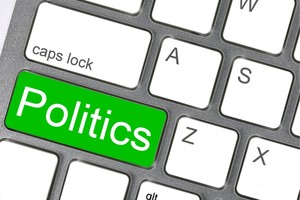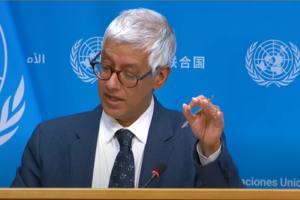US Trust in Media at 32% in Reuters Digital News Report

Each year since 2012, the Reuters Institute for the Study of Journalism has published a Digital News Report in which it presents data, details international trends regarding media consumption and attitudes, and reports changes in the media industry. The 2023 report covers 46 countries – which Reuters (Center bias) calls markets – accounting for over half of the world’s population.
According to the report, in the United States, only 32% of people trust the news. The report underscores serious challenges faced by the media industry – along with low trust, it also touches on increasing news avoidance and changing source preferences.
Let’s dig into the data.
The Reuters data show that when the public believes that the media is neglecting to provide free, unbiased information and hold powerful officials accountable, people don’t consider news consumption worthwhile.
Reuters reports that “trust in the news has fallen, across markets, by a further 2 percentage points in the last year, reversing in many countries the gains made at the height of the Coronavirus pandemic.” Overall, 40% of respondents said they trust the news.
Low trust is prevalent in countries facing polarization, like the US or Peru (33% trust), and in countries where major media outlets are perceived to be under the control of the government, like Argentina (30% trust) and Hungary (25% trust). In many countries, as trust levels fall, news avoidance rises, with citizens who feel that news is unreliable choosing to ignore the news entirely. In Greece (19% trust, 57% avoidance), avoidance has skyrocketed since the nation’s 2009-2018 debt crisis, which “spurred a further consolidation of media ownership among powerful business interests, many of them with ties to the political elite,” according to the Columbia Journalism Review (Center bias).
While faith in traditional media declines, people turn to different sources for information. In the 2023 report, social media leads direct news sources (the websites and apps of media outlets) as the top source of news consumption by 8%. In 2018, direct sources led social media by 9%. Although some countries, like Finland (63% direct) and Norway (59% direct) still overwhelmingly favor direct news sources, social media is a popular source in countries that lack reliable domestic news sources or nonpartisan aggregating platforms (platforms that collect and disseminate news stories from various sources). TikTok, in its short-form video style, has shown particularly strong growth in news consumption in countries with low trust; 60% of TikTok news users in Peru and 51% in Brazil (43% trust) said that they pay attention to national politics on the platform.
In the United States, low trust in media is frequently attributable to polarization, biased sources, and misinformation, but governments – in the United States and around the world – can also cause negative perceptions of the media. In some cases, heavy criticism of media by public authority figures influences public perception. In others, public service media — media that is in part funded by the public or government, like PBS NewsHour (Lean Left bias) — is perceived to be under the control of the government (whether it is or it is not), and trust decreases. In yet more cases, governments may actively regulate and restrict media freedom to a point where media cannot present trustworthy or complete stories.
According to Reuters, media criticism from political figures – a familiar phenomenon for the American AllSides reader – correlates to low levels of trust, either in that the criticism causes distrust or that distrust leads people to seek out criticism. Reuters acknowledges that media criticism can be good: calling out the media for its biases, unfair representations of stories, and other failings without promoting anti-media sentiment or fomenting negativity toward media institutions is important. It is when political figures discount some (or all) media as systemically bad that the industry itself can be damaged.

While 40% of respondents across all countries trust the news, 53% said that they are exposed to news media criticism “very” or “quite often,” with the high range of responses including Peru at 71%, and the low range including Japan at 22%. 58% of respondents in the United States said that they heard media criticism “very” or “quite often.” Reuters adds, “Political partisans are more likely to report that they ‘very often’ see news media criticism.” If people who lean more strongly to one side of the spectrum are more likely to be exposed to criticism, it stands to reason this criticism comes from either 1) partisan political figures or 2) partisan media that holds opposite biases.
More common is option 1. Overall, 42% of those that have been exposed to media criticism report they heard it from politicians or political activists. Notably, in the United States, that statistic rises to 58%.

Former U.S. President Donald Trump was well known for criticizing what he called “the Fake News Media.” At one point, Trump tweeted, “The Fake News Media, the true Enemy of the People, must stop the open & obvious hostility & report the news accurately & fairly,” and, “The Fake News is doing everything in their power to blame Republicans, Conservatives and me for the division and hatred that has been going on for so long in our Country. Actually, it is their Fake & Dishonest reporting which is causing problems far greater than they understand!” He also referenced “The Fake News of big ratings loser CNN.” (CNN is rated Lean Left by AllSides.) Further, Democratic Senate Majority Leader Chuck Schumer and House Minority Leader Hakeem Jeffries said in a March 2023 letter to Fox News (Right bias) founder Rupert Murdoch addressing false 2020 presidential election fraud claims, which led to a lawsuit in which Fox had to pay $780 million, “Though you have acknowledged your regret in allowing this grave propaganda to take place, your network hosts continue to promote, spew, and perpetuate election conspiracy theories to this day,” adding that “Fox News executives…can continue a pattern of lying to your viewers and risking democracy or move beyond this damaging chapter in your company's history by siding with the truth and reporting the facts.” The criticism and delegitimization – whether warranted or not – of some of the most popular media brands in the United States by major figures in politics sows distrust; CNN (Lean Left bias) is trusted by 45% and Fox News (Right bias) by 38% in the U.S. In an almost absurd twist that showcases the level to which partisanship and criticism of American media brands has affected trust, the most trusted brand in the United States (other than local television news) is the U.K.-based BBC News (Center bias).
Media criticism in the United States contributes to a hyper-polarized environment, but media criticism in other countries actually leads to the absence of reliable media and can also be linked to government restriction and suppression of media – a much more dangerous scenario than Trump, Jeffries, and Schumer’s simple criticism in a nation with express constitutional protections for the press.
The Reuters report concluded, “In markets with less robust press protections or declining press freedoms, criticism can take on a different character. On the back of anti-media rhetoric from populist politicians and hardline leaders, coordinated harassment campaigns can become super-charged by partisans on social media, and be dangerous and harmful for those at the receiving end.”
Reuters reports that Hungarian Prime Minister Viktor Orbán and Turkish President Recep Tayyip Erdoğan “continue in their long campaigns against independent journalists.” Covering government control of media, a 2022 Reuters Special Report said that Turkey’s media “has become a tight chain of command of government-approved headlines, front pages and topics of TV debate.” Hungary’s overall trust in media is recorded as 25% and Turkey’s as 35%.
Despite concerns about misinformation and corporate control, social media is popular in low-trust countries because it is harder for restrictive governments to regulate privately owned social media companies. In Peru, which is facing high levels of polarization, media bias, and government instability, Reuters recorded 30% of people who say that social media is their main source of online news, with just 10% of people choosing direct news. As expected, just 33% of Peruvians trust the news.
Overall lack of trust in the media has certainly driven people – especially younger populations – toward social media for news, but overwhelming criticism from politicians and other media, and just fundamental low trust in media institutions, are not just changing the way people read news. Lack of faith in traditional media is making people reconsider whether they should read news at all.
According to Reuters, people avoid news in three main ways: turning off news entirely, checking news less often, and avoiding specific stories or topics. News avoidance is highest in countries with low trust in the news – Greece (19% trust, 57% avoidance), Bulgaria (28% trust, 57% avoidance) and Argentina (30% trust, 46% avoidance) – but not all countries with low avoidance have high trust in the news: despite the low trust level (32%) in the United States, just 11% “sometimes or often avoid news and specific news topics,”
While the correlation between low-trust and overall high-avoidance is clear, avoidance of particular stories rather than news as a whole doesn’t come from lack of faith in the media. Finland – ranked as the nation with the highest level of trust in the 2023 Reuters Report at 69% – also has one of the lowest levels of avoidance – 21%. Yet, 75% of Finns avoid news about the war in Ukraine – the highest of any country surveyed. Thus, news avoidance is connected to news content, not just media outlets and governments themselves. Reuters concludes, “Our data may not suggest a lack of interest in Ukraine from nearby countries but rather a desire to manage time or protect mental health from the very real horrors of war. It may also be that consumers in these countries already consider themselves to be well-enough informed on Ukraine, with extensive and detailed coverage across all channels, including via social media.”
Reuters also finds that polarization and sensationalized “junk” news cause people to avoid polarizing topics. Comparing the highly polarized United States to a country with a more friendly political climate like Finland shows that connection: 20% more people in the United States avoid national political news and 13% more say they avoid social justice news. Meanwhile, people in Finland are only more likely than people in the United States to avoid news about the war in Ukraine and about health.
News avoidance in the United States presents data about issues that people on opposite sides of the spectrum regard completely differently; 70% of avoiders on the right avoid social justice news compared to 22% on the left, and 30% on the left avoid news about crime and personal security compared to 14% on the right.
Across countries, news avoiders say that they are more interested in positive news (55%) solutions (46%), and explainers (39%). News that is less negative, that presents a path forward, and that is more factual than opinion based. Yet, Reuters notes, “other research reminds us that in practice we are often drawn towards more negative and emotionally triggering news (Robertson et al. 2023). This may be true in the moment, but over time it seems to be leaving many people empty and less satisfied, which may be undermining our connection with and trust in the news.”

High rates of news avoidance are results of news that is biased, negative, or not free of influence, indicating that many populations are rejecting polarized media that prioritizes clickbait and sensationalism over true and factual reporting. While the growing rate of news avoidance presents problems for the media industry and may lead to an uninformed populus incapable of productive global citizenship, it also shows that more and more people are ready for a change in the way they get their news.
As news preferences change, with trust low, avoidance rising, and print and broadcast media becoming less and less popular, outlets focus their attention on online media.


As aforementioned, low trust in news outlets is leading to the rise of social media, which provides a platform for news to be disseminated outside of traditional – and more easily controlled, regulated, and suppressed – media channels, but raises concerns about misinformation, bias, and big-tech-owned companies’ power over media.
Although Facebook, previously the top social platform for news consumption, is no longer leading in the field because of policy changes from its parent company, Meta, news continues to be shared by journalists, outlets, influencers, and “average people” on social media platforms. Reuters reports that, on TikTok, people are more likely to listen to influencers or average people than journalists. The app gives users the opportunity to hear from people outside of untrusted media outlets and even outside of their own nation, but the algorithm also lends itself to the creation of filter bubbles, and misinformation can be spread with ease.
As the Reuters report shows, the media issues AllSides is addressing in the United States are not exclusive to our nation. Polarization is not a solely American story, news reports are discouraging around the world, and bias and misinformation exist in international media, too. Perhaps if the world understands and faces these problems together, it can overcome them together.
Ian Rosenzweig is a Content Intern at AllSides. He has a Center bias.
This blog was reviewed by Andrew Weinzierl, Bias Research Manager and Data Journalist (Lean Left bias), Joseph Ratliff, Daily News Editor (Lean Left bias) and Julie Mastrine, Director of Marketing and Media Bias Ratings (Lean Right Bias)


May 16th, 2024

May 16th, 2024

May 16th, 2024